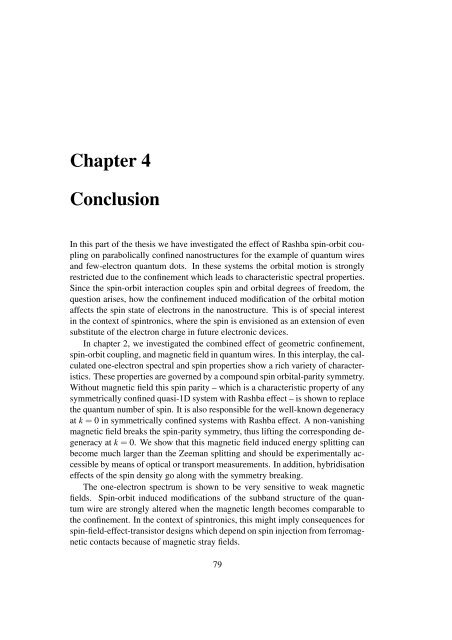Spin-orbit coupling and electron-phonon scattering - Fachbereich ...
Spin-orbit coupling and electron-phonon scattering - Fachbereich ...
Spin-orbit coupling and electron-phonon scattering - Fachbereich ...
You also want an ePaper? Increase the reach of your titles
YUMPU automatically turns print PDFs into web optimized ePapers that Google loves.
Chapter 4<br />
Conclusion<br />
In this part of the thesis we have investigated the effect of Rashba spin-<strong>orbit</strong> <strong>coupling</strong><br />
on parabolically confined nanostructures for the example of quantum wires<br />
<strong>and</strong> few-<strong>electron</strong> quantum dots. In these systems the <strong>orbit</strong>al motion is strongly<br />
restricted due to the confinement which leads to characteristic spectral properties.<br />
Since the spin-<strong>orbit</strong> interaction couples spin <strong>and</strong> <strong>orbit</strong>al degrees of freedom, the<br />
question arises, how the confinement induced modification of the <strong>orbit</strong>al motion<br />
affects the spin state of <strong>electron</strong>s in the nanostructure. This is of special interest<br />
in the context of spintronics, where the spin is envisioned as an extension of even<br />
substitute of the <strong>electron</strong> charge in future <strong>electron</strong>ic devices.<br />
In chapter 2, we investigated the combined effect of geometric confinement,<br />
spin-<strong>orbit</strong> <strong>coupling</strong>, <strong>and</strong> magnetic field in quantum wires. In this interplay, the calculated<br />
one-<strong>electron</strong> spectral <strong>and</strong> spin properties show a rich variety of characteristics.<br />
These properties are governed by a compound spin <strong>orbit</strong>al-parity symmetry.<br />
Without magnetic field this spin parity – which is a characteristic property of any<br />
symmetrically confined quasi-1D system with Rashba effect – is shown to replace<br />
the quantum number of spin. It is also responsible for the well-known degeneracy<br />
at k = 0 in symmetrically confined systems with Rashba effect. A non-vanishing<br />
magnetic field breaks the spin-parity symmetry, thus lifting the corresponding degeneracy<br />
at k = 0. We show that this magnetic field induced energy splitting can<br />
become much larger than the Zeeman splitting <strong>and</strong> should be experimentally accessible<br />
by means of optical or transport measurements. In addition, hybridisation<br />
effects of the spin density go along with the symmetry breaking.<br />
The one-<strong>electron</strong> spectrum is shown to be very sensitive to weak magnetic<br />
fields. <strong>Spin</strong>-<strong>orbit</strong> induced modifications of the subb<strong>and</strong> structure of the quantum<br />
wire are strongly altered when the magnetic length becomes comparable to<br />
the confinement. In the context of spintronics, this might imply consequences for<br />
spin-field-effect-transistor designs which depend on spin injection from ferromagnetic<br />
contacts because of magnetic stray fields.<br />
79
















